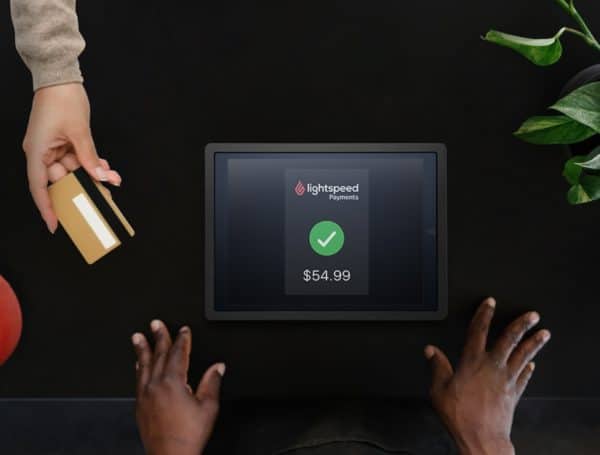
 Lightspeed POS (Lightspeed POS Stock Quote, Chart, News TSX:LSPD) is not an inexpensive stock, but it is a buy because its growth is likely to accelerate.
Lightspeed POS (Lightspeed POS Stock Quote, Chart, News TSX:LSPD) is not an inexpensive stock, but it is a buy because its growth is likely to accelerate.
So says PI Financial analyst Gus Papageorgiou, who on Wednesday initiated coverage of the Montreal-based ecommerce player with a “Buy” rating and one-year price target of $38.00, which implied a return of 28 per cent at the time of publication.
Lightspeed POS Stock “Not Cheap…”
“It’s not cheap,” Papageorgiou cautions. “LSPD has doubled since IPO and trades at 15.5 EV/Sales. The shares are likely to continue to trade at lofty valuations as long as the Company performs. But (the) outlook looks promising: We expect revenue growth will accelerate over the next three years as Payments adoption grows, more locations are added, and existing customers adopt more software modules. We do not expect high levels of profitability in the medium term. We value LSPD on an EV/Sales multiple of 11.5x next 12-month revenues one year out (FQ221-FQ122). Our DCF is also supportive at $38.00. The shares do not have a long trading history as the Company recently undertook its IPO. But given the prospects for growth are strong we believe LSPD will trade at lofty valuations.”
The analyst says Lightspeed, which sells a SaaS-based Point-of-Sales solution for small to medium businesses, is growing for a very simple reason: it helps customers succeed. He notes that the average Lightspeed client sees a 20 per cent bump in revenue, and that between 2016 and 2019 the average customer saw a whopping 77 per cent increase in revenue.
Papageorgiou invokes Greek mythology to describe the effect that Lightspeed has in the market, comparing it to Prometheus.
Prometheus
“In ancient Greek mythology Prometheus was a Titan that stole fire from the gods and gave it to mankind allowing progress and civilization – unfortunately for him he was punished by being eternally bound to a rock and having his liver eaten out day after day by an eagle — ouch,” explained the analyst. “Hopefully Lightspeed will not suffer the same fate but in a way this Company can be thought of as the Prometheus of enterprise software. Lightspeed allows small and medium businesses (SMBs) to run their business with the assistance of sophisticated data driven software. Something that in the past was either impossible or prohibitively expensive.”
Papageorgiou says the democratizing effect of SaaS software means SMBs can compete on an equal footing, more or less, with the big boys.
“Lightspeed operates as a SaaS platform,” he notes. “This allows its customers to have access to the most up to-date software in an affordable manner without the need for high levels of technical sophistication. It also allows for global reach of the platform since all that is really needed is a high speed internet connection and a computing device (smartphone or tablet). Because the software itself is centralized, updates can be made once and shared by all users so everyone is always on the latest version of the software. There is no expensive up-front expenditure necessary and users pay on a monthly basis. This allows for a reliable recurring revenue stream. Lightspeed offers its customers monthly, annual or multi-year plans but approximately 70% of the customer base sign on for a year or longer – providing a high degree of forecast accuracy.”
Papageorgiou thinks Lightspeed will post EBIT of (All figures USD) negative $27.6-million on revenue of 112.1-million in fiscal 2020. He expects those numbers will improve to EBIT of negative $12.2-million on a topline of $179.7-million the following year.
Lightspeed Payments is What’s Next…
The analyst says a potentially huge new development could be on the horizon in the form of Lightspeed Payments, which launched in the U.S earlier this year. Until this launch, payments was a third-party account for clients using Lightspeed POS.
“Payments is where the real growth lies: As strong as the growth to date has been we believe that Lightspeed Payments can actually accelerate the overall growth,” he said.
“Payments has proven to be a very effective offering for similar companies such as Shopify and Square. Shopify, for example, launched its Payments offering in 2013, when it recognized 3.6M in revenue. By 2016, three years later, that had grown to $162.3M. Shopify first launched Payments in the U.S, market but then quickly expanded it globally, and continues to do so. By last quarter 42% of its equivalent GTV was flowing through its payments system. To gain a sense of how relevant Payments can be for Lightspeed, if last year Lightspeed had a similar level of success as Shopify with its Payments platform its revenues would have been $228.3M or 195% higher than the $77.5M it had recorded.”
Leave a Reply
You must be logged in to post a comment.




 Share
Share Tweet
Tweet Share
Share




Comment